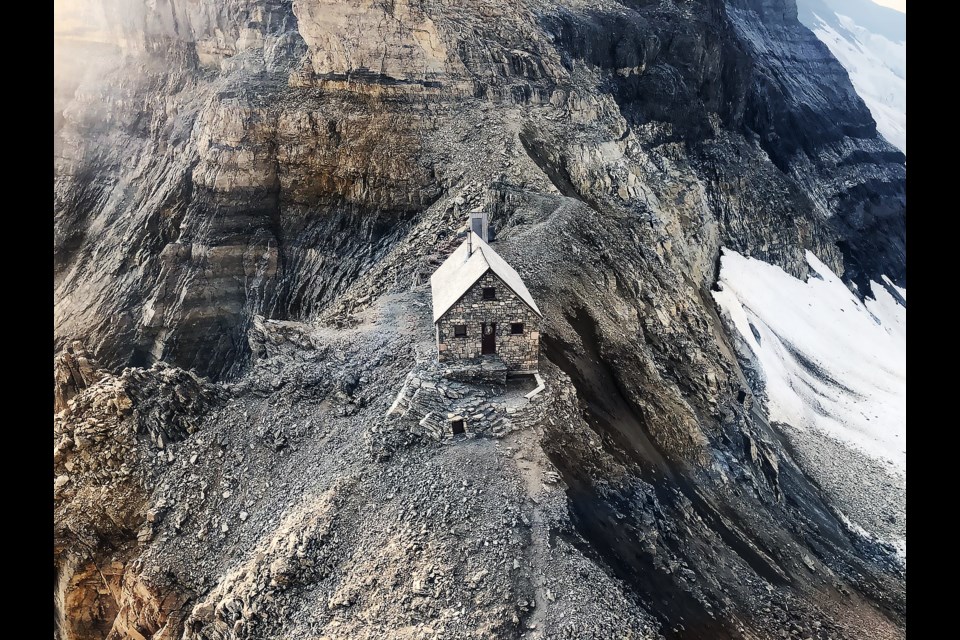LAKE LOUISE – A historic cabin will be dismantled and removed due to the impacts of slope erosion and glacial recession from climate change, Parks Canada announced Thursday.
The Abbot Pass refuge cabin national historic site will be removed this spring following geotechnical assessments that showed 114 cubic metres of material fell from the slope beneath the hut after high temperatures this past summer.
“I’ve known about Abbot pass hut significance for many years. It’s a sad day for us all,” said Rick Kubian, the field unit superintendent for Yoho, Kootenay and Lake Louise “We do want to move forward and I tend to be someone who tries to take the best from a tough situation and I’m hopeful others are able to take the ability to recognize the hut and its significance.”
Parks Canada began a geotechnical assessment following reports of rockfall and erosion being found in the fall of 2016.
Slope stabilization was completed in 2018 for $600,000, which saw rock anchors added to support the cabin.
However, an additional geotechnical assessment was completed in 2021 and discovered higher levels of slope erosion and cracks in the masonry. It was determined further slope stabilization efforts wouldn’t preserve the hut.
When the hut was built in 1922, the southeast slope below it was covered by permanent snow and ice. However, the snow and ice have receded and exposed the steep slope below the hut and erosion was first noticed in 2016.
Kubian said the impacts of climate change on the site led to the difficult decision and the agency is taking measures to protect its sites.
“Climate change and other environmental forces challenge the integrity of ecosystems and the condition of Parks Canada natural resources,” he said. “We’re taking action on a wide arrange of fronts, including invasive species, actions related to our assets and trying to protect our assets from the effects of climate change.”
Kubian said no other locations are at the same risk as Abbot Pass and an initial look has been done, but a more detailed one will be completed.
A heritage recording has been completed and once the hut’s removed, the area around the site will be reopened.
While efforts will be made to remove the majority of the hut, it was noted its unstable condition could pose a safety risk to workers deconstructing the hut. The masonry is primarily made of limestone and could fracture if removed.
The intent is to remove as much non-natural material and Parks Canada will look at leaving a footprint on the site to further commemorate its location.
A location to remove it has yet to be decided and consultations with Indigenous groups, the Alpine Club of Canada, stakeholders and the public will happen this year to look at options to commemorate the original site of the cabin and where the cabin will be removed.
“We really haven’t put any detailed thinking into that yet. You could picture enough rock to build a cairn or series of cairns at locations is one of the conceptual things we’ve discussed,” Kubian said. “We really want to work with stakeholders in the alpine and mountaineering community as well as with Indigenous peoples to determine that path forward and we think we’ve got time to do that.”
The hut is at an elevation of 2,925 metres on the border of Banff and Yoho national parks near Lake Louise.
It was built in 1922 by Swiss guides and acquired by Parks Canada in 1968. The Alpine Club of Canada has operated since 1985 for what has become a popular spot for hikers and mountaineers.
In 1992, it was made a national historic site and a series of upgrades to the roof, drainage, masonry was made between 2012 and 2014.
The work to remove it is expected to be carried out in the spring and will look to be finished before the busy tourism season returns this summer.
“We’re hopeful we have the work done prior to the primary summer season,” Kubian said. “That is one of our main drivers is to make sure we’re able to remove the area closure that’s been in place since the hut’s been identified as a threat to public safety.”
Timeline:
- 1922: Abbot Pass refuge cabin (Abbot Pass Hut) constructed
- 1968: Dominion Parks Branch (known today as Parks Canada) acquires the hut
- 1973: Abbot Pass refuge cabin is restored
- 1985: Alpine Club of Canada assumes operation of the hut
- 1992: Abbot Pass refuge cabin is designated as a national historic site
- 2012: Parks Canada completes roof and drainage upgrades
- 2014: Parks Canada completes stone masonry restoration
- 2016: Initial slope instability reported to Parks Canada
- 2017: Slope stability geotechnical assessment begins
- 2018: Hut closed and initial slope stability work conducted to install rock anchors below the hut
- 2019: Unfavourable weather conditions cause safety concerns at the site, preventing additional slope stability work
- 2020: COVID-19 health measures prevent additional slope stability work from being completed
- 2021: Further slope erosion occurs, impacting the base of the hut
- Area closure expanded to include Abbot Pass and its two approach routes
- Second geotechnical assessment conducted
- Heritage recording completed
- 2022 (anticipated): Abbot Pass hut removed
Correction: The original online version stated that the Abbot Pass hut was going to be moved, but it actually is going to be removed this spring. The Outlook apologizes for the confusion.




